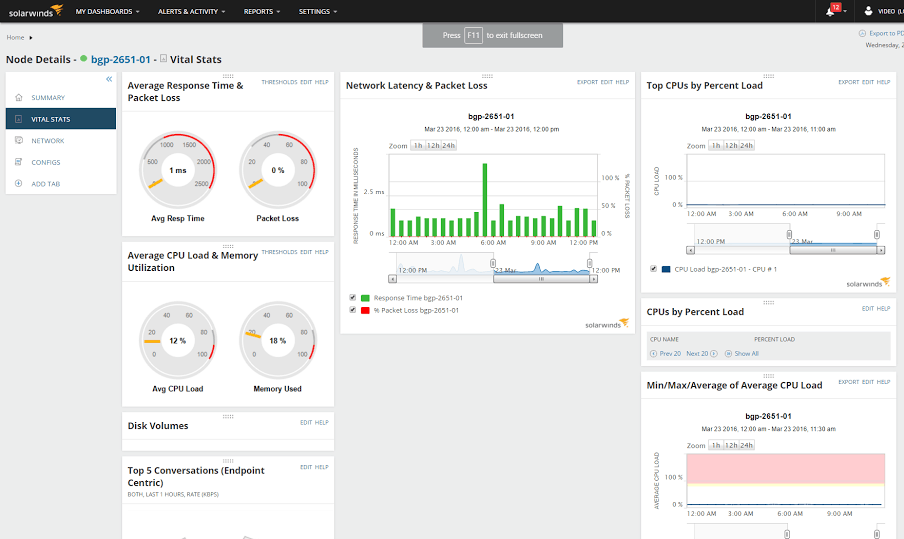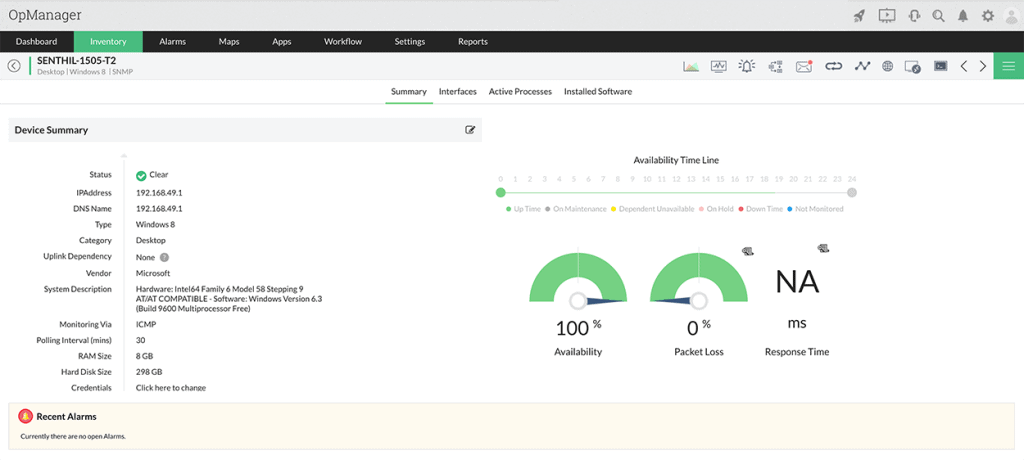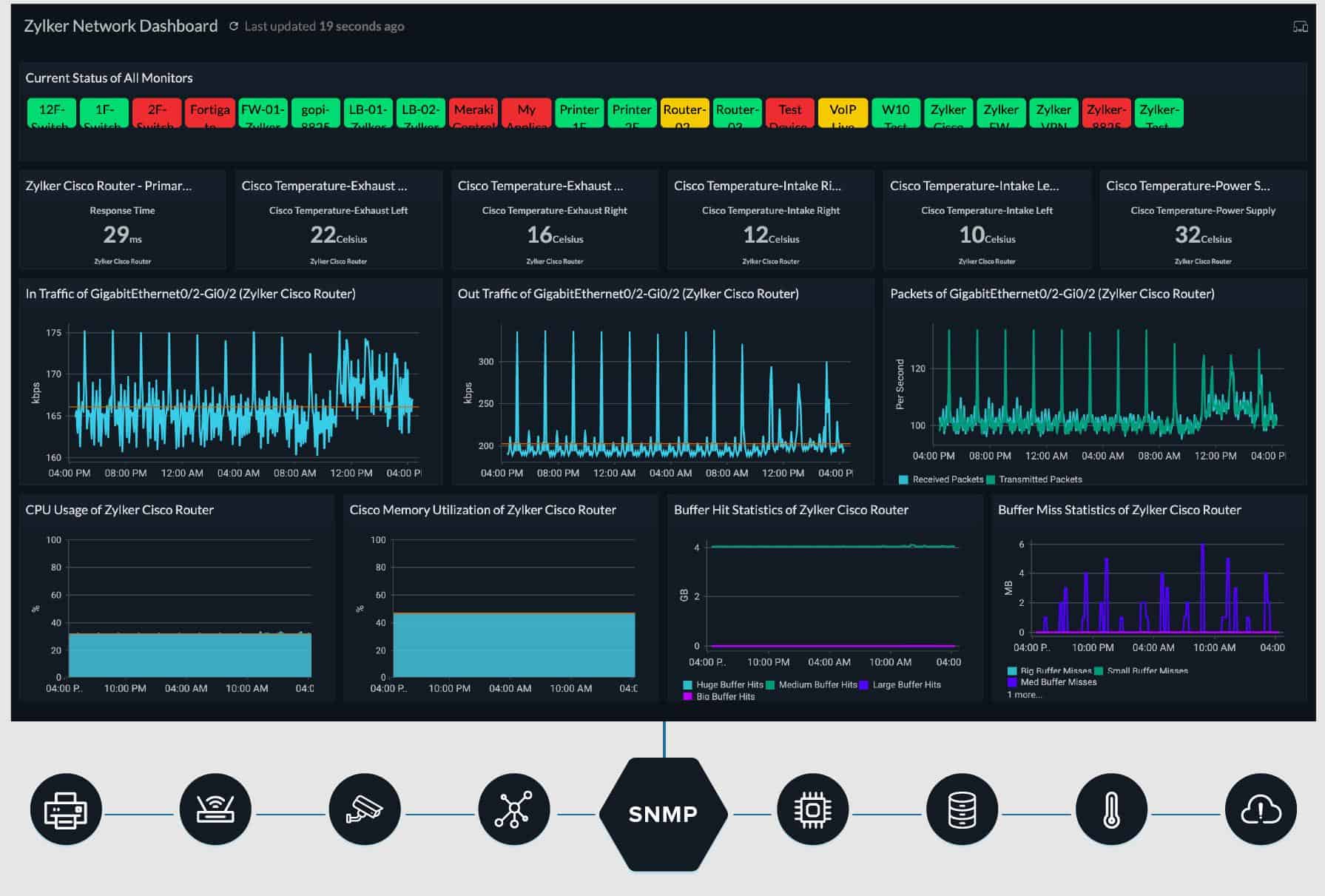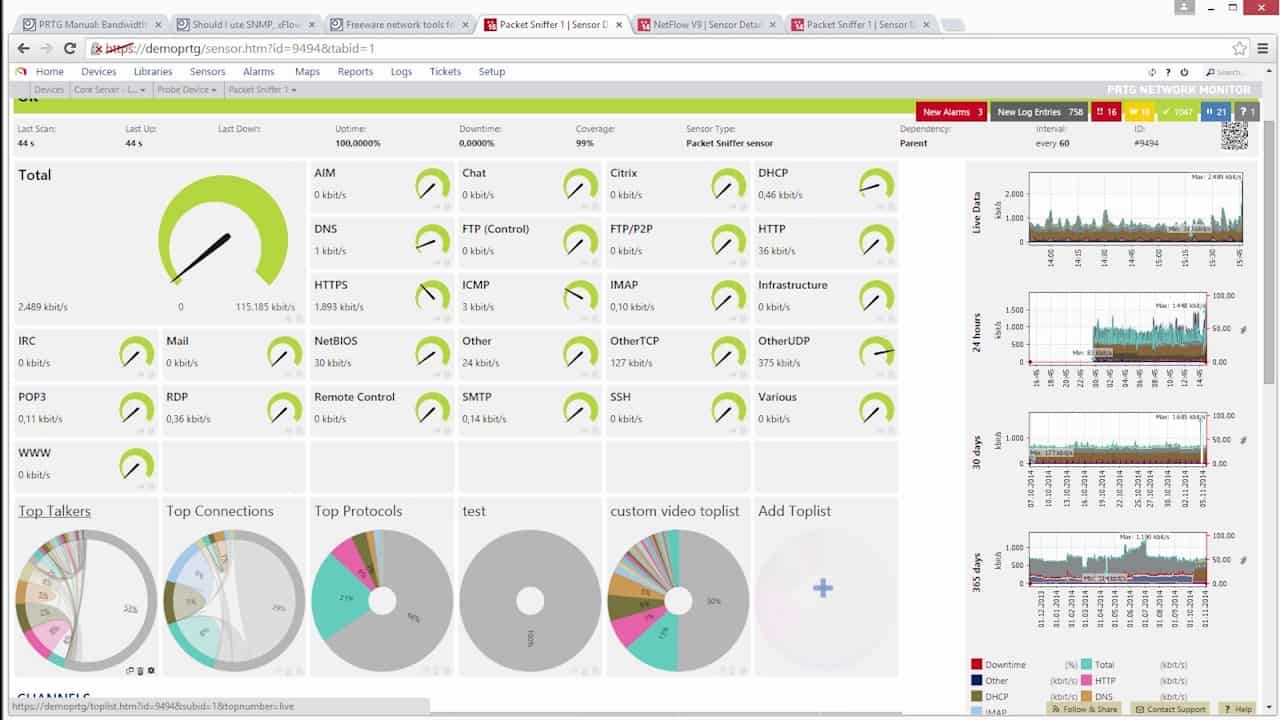Our funding comes from our readers, and we may earn a commission if you make a purchase through the links on our website.
Network Optimization – A Quick Guide to Get You Started!
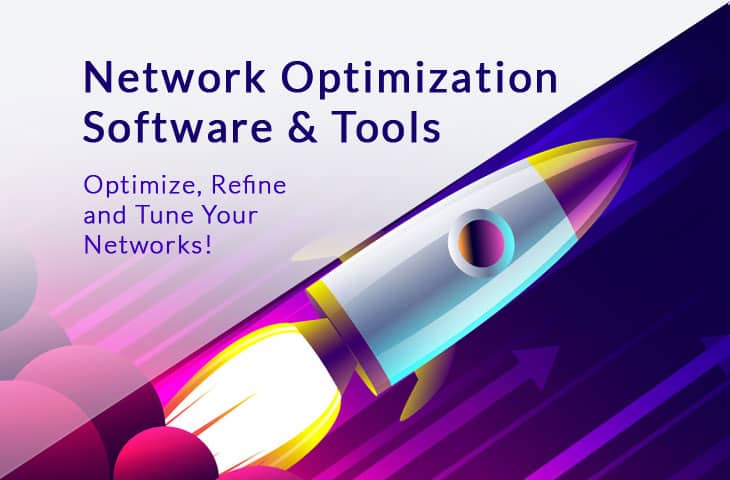
UPDATED: January 10, 2024
The Internet is not only developing. It is exploding!
The following is NOT a picture of our Galaxy. It is a picture of the Internet.
The Internet is an expanding system of millions of connections, which is getting bigger and more complicated by the day.
It's calculated that there will be 4.3 billion Internet users in the whole world by March 2019. But Internet usage increase is not only related to the population, it is also affected by the number of devices. Thanks to the Internet of Things “IoT,” it is expected that there will be more than 64 billion devices connected to the Internet worldwide by 2025.
This rapid growth is putting extreme pressure on our local networks. Our cloud storage, web apps, remote servers, VoIP calls, all of these depend entirely on the Internet.
To avoid poor end-user experience and lousy quality of service, you don’t have to go out and buy large and powerful resources. You only need to learn how to adapt and optimize your local networks.
Here is our list of the top network optimization tools:
- SolarWinds Network Performance Monitor – FREE TRIAL This SNMP-based system includes autodiscovery, network inventory creation, and automatic network topology mapping as bases for live activity monitoring. Available for Windows Server. Start a 30-day free trial.
- ManageEngine OpManager – FREE TRIAL This tool monitors networks and servers and it uses SNMP to examine the load on network devices plus their availability statuses. Available for Windows Server and Linux. Download a 30-day free trial.
- Site24x7 – FREE TRIAL Excels as a network optimization software, meeting the demands of modern network environments focused on efficiency and performance. It offers advanced monitoring of network parameters like bandwidth, packet loss, and latency, coupled with AI-powered analytics for bottleneck resolution. Start a 30-day free trial.
- Paessler PRTG Network Monitor – FREE TRIAL A collection of monitors for networks, applications, and servers that includes SNMP performance reports, and live topology mapping. Runs on Windows Server. Access a 30-day free trial.
- Progress WhatsUp Gold This network performance monitoring package works with SNMP and includes live network topology mapping. Runs on Windows Server.
What is Network Optimization?
Network Optimization is a set of technologies and methods that aim to improve the overall health of a network. It takes care of every single component, from the workstation to the server, their processes, and connections.
Network optimization helps you to keep track of specific performance metrics like bandwidth usage, availability, packet loss, latency, and jitter. It gives you essential information so that you can tweak what is necessary.
The goal of network optimization should not be to buy more powerful hardware or software resources but to optimize what is already in our hands. Traffic Engineering “TE” and Quality of Service “QoS” are two common optimization methods that can help improve the performance of these metrics in voice or data networks.
Why is Network Optimization Important?
Network optimization is essential for end-user experience, employee productivity and cutting down business costs.
For example, when there is latency in the network, an online application or website can take a long time to load. In other cases, packet loss, jitter, or delay can affect technologies such as VoIP or databases. Poor bandwidth allocation can also affect end-user experience and employee productivity.
Monitoring these factors and keeping them under certain thresholds is the key. Network Optimization aims to improve (or reduce) the following metrics:
- Uptime (availability)
- Bandwidth consumption or utilization
- Traffic
- Delay, Latency, Jitter
- Packet Loss
- Duplicate Packets
- Errors and discards
- CPU and memory
- WAN performance
Network Optimization with Tools
For now, no single product can be considered as a pure Network Optimization Tool. There are just too many factors that affect how a network behaves and how it should be optimized. But, there are a few tools that can help improve parameters through passive or active network performance monitoring.
These tools can help you, but will not automatically optimize your network. Adjusting it should be the role of the network engineer. New technologies such as Software-Defined-Networks “SDN” and Networks-Function-Virtualization “NFV” can also help improve it. With these technologies, network devices can now be controlled via code and their performance metrics optimized actively.
The tools listed below will help you monitor your traffic, metrics, protocols, and topologies. Some of these tools are beginning to support SDN and NFV monitoring.
The Best Network Optimization Software & Tools
1. SolarWinds Network Performance Monitor – FREE TRIAL
Network Performance Monitor developed by SolarWinds, is one of the best network management and monitoring tools on the market. NPM is an intuitive and easy-to-use software. It can monitor performance, availability, and faults on your network.
NPM Network Optimization Key Features include:
- SolarWinds NPM supports SDN monitoring.
- Hop-by-hop analysis of paths.
- Network monitoring for many different vendors.
- Smart scalability for large network environments.
- Powerful alerting system.
- Automatically generated intelligent maps.
- Easy troubleshooting with PerfStack and NetPath.
NPM allows you to optimize the network by displaying faulty nodes and letting you view its current state, information, average response time, packet loss, latency, CPU, etc. For example, with NPM, you can see that the status of a node is up and running but its metrics such as Round-Trip Time “RTT” and packet loss are high.
You can analyze these metrics and implement network optimization with NPM. The software includes a Quality of Experience “QoE” dashboard that uses Deep-Packet-Inspection “DPI” to provide you with packet-level traffic information and to calculate network latency. With this information, you can find the sources of network issues and improve your network.
Pros:
- Takes a holistic approach to server performance and health monitoring
- Supports auto-discovery that builds network topology maps and inventory lists in real time based on devices that enter the network
- Supports both SNMP monitoring as well as packet analysis, giving you more control over monitoring than similar tools
- Uses drag and drop widgets to customize the look and feel of the dashboard
- Robust reporting system with pre-configured compliance templates
Cons:
- Designed for IT professionals, not the best option for non-technical users
Start with a 30-day free trial and figure out what your requirements are.
2. ManageEngine OpManager – FREE TRIAL
OpManager is a robust network monitoring and management software, developed by ManageEngine. This tool is capable of keeping track of your network performance in real-time and actively finds faults. With OpManager you can monitor every single device in your distributed networks, remote offices, and your cloud environments.
OpManager helps you optimize your network by monitoring the following key factors.
- Availability: OpManager helps you keep uptime maximized by sending pings at scheduled intervals. If a device is unresponsive or there is a large packet loss average, the tool will start an alarm or send you an alert.
- CPU and Memory: OpManager uses SNMP, WMI, Telnet, SSH, and VMWare native API to monitor the physical or virtual aspects of a server. You can find and troubleshoot CPU and memory issues, like utilization, speed, idle time, before they affect the service. When these parameters go over a certain threshold, you’ll receive an alert.
- Bandwidth: OpManager can help you find bandwidth hogs or traffic bottlenecks in your network. You can analyze the overall bandwidth performance and traffic patterns with NetFlow.
- Errors and discards: OpManager keeps control of the packet loss in a connection due to errors and packet discards. It achieves this with the help of NetFlow.
- WAN performance: With OpManager you can keep track of your WAN connections, their traffic, and latency. It uses Cisco’s IP-SLA for monitoring WAN links.
OpManager allows network optimization in large networks. It has high scalability for up to 10,000 nodes while protecting their availability and uptime.
Pros:
- Features a suite of automated and manual monitoring tools for various helpdesk needs
- Can be installed on both Windows and Linux platforms, making it more flexible than other on-premise options
- Offers in-depth reporting, ideal for enterprise management or MSPs
Cons:
- ManageEngine provides a suite of monitoring tools that can take time to fully learn and understand
OpManager comes with four different pricing models, Essential, Enterprise, Service Packs, and Free. Their price is not on the official site of ManageEngine, but you can request a quote. The Free OpManager edition, and optimize the performance for up ten devices for an unlimited time. Start with a 30-day free trial.
3. Site24x7 – FREE TRIAL
Site24x7 stands out as a prominent choice for network optimization software, catering to the needs of modern network environments where efficiency and performance are paramount. This tool is particularly effective for organizations aiming to enhance their network performance and reliability through advanced optimization techniques. Site24x7’s comprehensive approach to network optimization makes it an excellent choice for those seeking to maximize their network resources and improve user experience.
Key Features
- Advanced network performance monitoring, including bandwidth analysis, packet loss, and latency tracking
- AI-powered analytics for identifying and resolving network bottlenecks and inefficiencies
- Automated network configuration and optimization tools
- Customizable alerts and reporting features for proactive network management
- Integration with overall IT infrastructure monitoring for a unified approach to optimization
Why do we recommend it?
Site24x7 is recommended for its robust network optimization capabilities, enhanced by AI-powered analytics and comprehensive performance monitoring. Its automated optimization tools and insightful analytics make it a valuable asset for any organization looking to improve network efficiency and reliability.
Who is it recommended for?
This tool is particularly suitable for network administrators and IT professionals in medium to large enterprises that manage complex network infrastructures. Its ability to provide a detailed overview of network performance and identify optimization opportunities makes it ideal for environments where network efficiency is critical.
Pros:
- Comprehensive network performance monitoring and analytics
- AI-powered optimization for improved network efficiency
- Customizable alerts and detailed reporting for proactive management
Cons:
- Might be overly complex for smaller networks or organizations with basic optimization needs
4. Paessler PRTG Network Monitor – FREE TRIAL
PRTG Network Monitor is developed by Paessler AG, which is a large multinational company that creates IT infrastructure monitoring software. PRTG Network Monitor is an advanced monitoring tool for small, medium, and enterprise networks. With it, you can monitor any component in your infrastructure, such as Servers and Systems, applications, hardware, traffic, databases, Wireless Access Points, storage, bandwidth, cloud, virtual, security, IoT, etc.
PRTG monitors the following key network optimization indicators:
- Uptime PRTG can help you keep your uptime to 24/7. It provides detailed statistics of the availability so that you can find sources of errors and reduce downtime.
- Bandwidth Keep track of the bandwidth utilization in your network and test it frequently to ensure the SLA from the provider. PRTG uses SNMP, WMI, and Netflow to give you an overview of performance data.
- Latency The PRTG network utility helps you track the lag in your network. It uses a QoS sensor to find packet delay, loss, jitter, and duplicate packets.
PRTG has a flexible licensing model based on sensors and supports most popular networking vendors. It uses monitoring sensors, which are components within a single device. Sensors give a lot of flexibility. They can monitor an element such as CPU utilization, bandwidth, HTTP, etc. A single device can have one or up to a hundred sensors.
This tool can help you optimize your network by providing broad information on every single component. Once you see a failure in a node in PRTG’s dashboard, you can configure the hardware or software.
Pros:
- Uses a combination of packet sniffing, WMI, and SNMP to report network performance as well as discover new devices
- Autodiscovery reflects the latest inventory changes almost instantaneously
- Drag and drop editor makes it easy to build custom views and reports
- Supports a wide range of alert mediums such as SMS, email, and third-party integration
- Supports a freeware version
Cons:
- Is a very comprehensive platform with many features and moving parts that require time to learn
- Custom sensors can sometimes be challenging to manually configure
PRTG is 100% free for up to 100 sensors. You can upgrade to a paid license, that starts at $1,600 (USD) for PRTG 500, which allows monitoring up to 500 sensors and one server installation. You can run up to 100 sensors for free, and you can start with a 30-day free trial.
4. Progress WhatsUp Gold
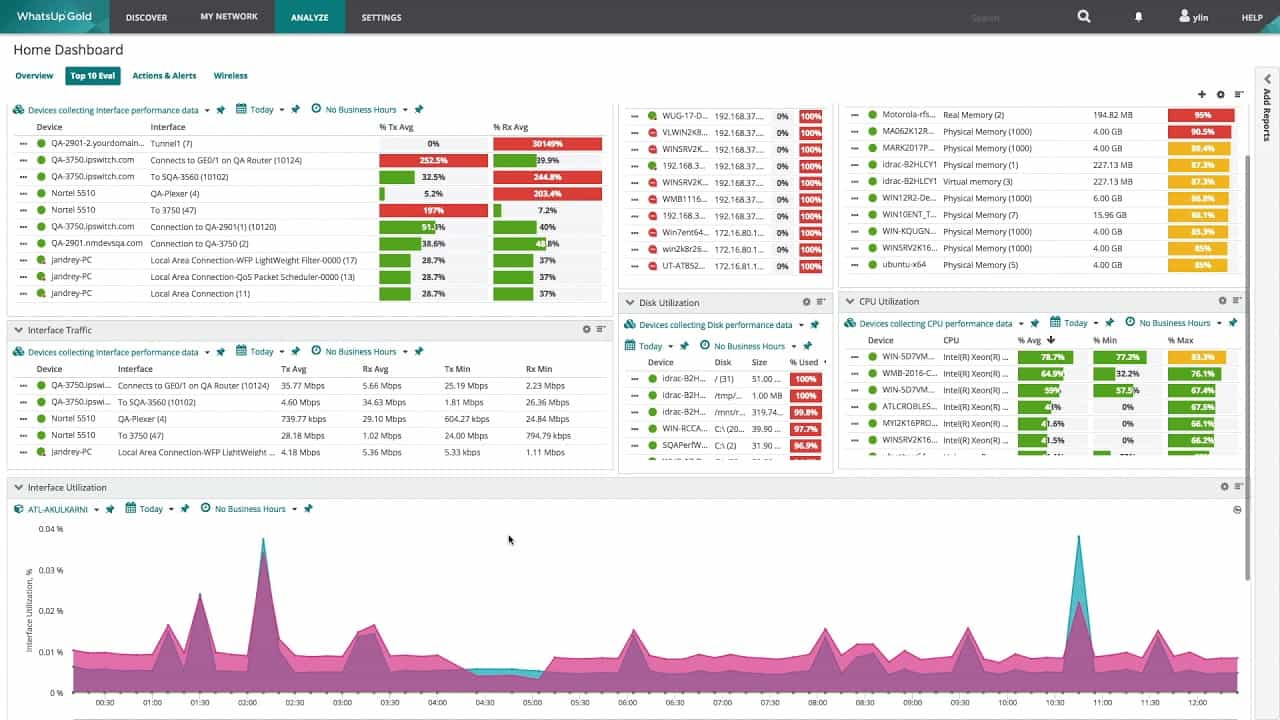
WhatsUp Gold“WUG,” developed by Progress, is another network management and monitoring software. This tool can keep track of the availability and performance of the entire infrastructure for small to medium size networks.
How to optimize your network with WhatsUp Gold:
- Bandwidth Optimization:
Network Traffic Analysis plug-in module allows you to monitor bandwidth and analyze traffic. The solution uses a variety of protocols such as NetFlow, NSEL, QUIC, sFlow, J-Flow, and IPFIX. - Ping status/latency:
WUG is capable of checking latency and availability through ping response time measurements, and send alerts if there is no response or too much packet loss. - Monitor performance of applications:
A tool such as VoIP monitor is capable of continuously assessing performance and health of VoIP call quality. Another one is SQL Server monitor, which can monitor your SQL database and send alerts if there is a failure. - QoS Policies:
Give different priorities to different types of traffic with QoS policies. Allocate the right bandwidth to the most critical applications such as VoIP, CRP, databases, etc.
WhatsUp Gold gives you an overall view of the health of the network, devices, applications, and servers on-premises or in the cloud. It comes with a simple-to-use but comprehensive dashboard that will show newly discovered devices, statistics, and failure alerts.
Pros:
- Uses simple visualizations to help provide at-a-glance insights
- Supports modular pricing, allowing companies to pay only for features they intend to use
- Ideal for SMB environments
- Excellent dashboard and reporting visuals
- Can monitor LANs, WANs, and cloud-based applications such as container environments
Cons:
- Modular upgrades might not be a good fit if you intend on utilizing all aspects of a networking monitor
The price for WUG is not in the official site, so you’ll need to get a quote. Get a free trial on WUG from the official site.
Conclusion
The growth of the Internet is putting extreme pressure on our networks. Our local communication with remote servers, customers on the other side of the world, cloud storage, and even our mobiles depend entirely on the Internet.
If your network is already weak, it may cause poor quality of service to end-users. Even worst, it could make your employees unproductive and probably make a few customers unhappy. Your network needs to be ready and able to adapt to this growth.
But going out and buying more powerful resources is not always the best solution. You only need to learn how to optimize your current network with the help of a few methodologies and tools. Making sure your network design is at its best, and at the lowest possible cost is the best way to start.
Network Optimization can help in faster data transfers, improve disaster recovery, decrease bandwidth expenses, and improve response times for critical applications such as VoIP or databases.
All the tools listed above will help you optimize your network by analyzing performance metrics. But \SolarWinds NPM is the only one on the list that just started to support SDN monitoring, which can make a huge difference in terms of automatically optimizing your network via code.
Network Optimization FAQs
How often should I perform network optimization?
The frequency of network optimization depends on the specific requirements of your environment and the size and complexity of the network. In general, it is recommended to perform regular network optimization on an ongoing basis to ensure that the network is running optimally and to identify and resolve issues as they arise.
What should I do if I encounter a performance issue with the network?
If you encounter a performance issue with the network, the first step is to gather information about the issue and the environment, including network utilization and response time. You can then use this information to identify the root cause of the issue and take appropriate action, such as reconfiguring network devices, upgrading network components, or optimizing network bandwidth. If the issue cannot be resolved, you may need to seek additional support from the vendor or the network administrator.
How do I optimize network bandwidth?
Network bandwidth can be optimized by implementing bandwidth management techniques, such as traffic shaping, bandwidth limiting, and quality of service (QoS) policies. These techniques allow network administrators to control how network resources are used and prioritize network traffic to ensure that critical applications receive the necessary network resources.
What is the difference between network optimization and network tuning?
Network optimization and network tuning are similar in many ways, as both involve improving the performance and efficiency of a computer network. However, network optimization typically involves making broader changes to the network, such as reconfiguring network devices, upgrading network components, or implementing security measures. Network tuning, on the other hand, typically involves making more targeted changes to network settings and configurations to improve network performance.

